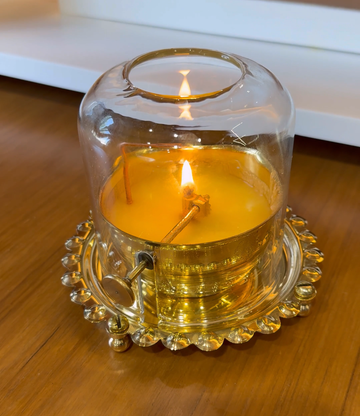The tradition of lighting an Akhand Jyot Diya holds deep spiritual significance in Hindu culture. This sacred lamp, kept burning continuously, symbolizes the eternal presence of divine energy and invokes blessings, peace, and prosperity. Whether in homes, temples, or places of worship, the Akhand Jyot serves as a beacon of faith and devotion.
Significance of Akhand Jyot
The word Akhand means “unbroken” or “eternal,” and Jyot translates to “flame” or “light.” Together, Akhand Jyot signifies an unceasing divine presence. It is believed that lighting an uninterrupted diya pleases the deities and attracts positive vibrations.
In Hinduism, fire (Agni) is considered a powerful medium that connects the devotee to the divine. The flame of the Akhand Jyot represents purity, truth, and enlightenment, dispelling darkness and negativity. Many households and temples maintain an Akhand Jyot during religious ceremonies, Navratri, Diwali, and special pujas dedicated to deities such as Goddess Durga, Lord Hanuman, and Lord Vishnu.
Benefits of Lighting an Akhand Jyot
-
Invokes Divine Blessings: Keeping the flame burning symbolizes the unwavering presence of the divine, inviting grace and guidance into one’s life.
-
Dispels Negativity: A continuous flame is said to ward off negative energies, fostering positivity and harmony in the surroundings.
-
Brings Prosperity and Peace: Many believe that an Akhand Jyot brings wealth, happiness, and spiritual fulfillment to the household.
-
Strengthens Faith and Devotion: The commitment to maintaining an eternal flame deepens one’s spiritual connection and devotion to the divine.
How to Light and Maintain an Akhand Jyot
-
Choose a pure brass or clay diya and place it in a sacred space.
-
Use pure ghee or sesame/mustard oil for a bright and steady flame.
-
Select a cotton wick, ensuring it is soaked well in oil or ghee.
-
Keep the diya covered with a glass case or lamp cover to protect it from wind or disturbances.
-
Ensure someone is always present to monitor the flame and refill oil or ghee as needed.
-
Recite prayers, bhajans, or mantras while lighting the diya for enhanced spiritual benefits.
Occasions for Lighting Akhand Jyot
-
Navratri – Dedicated to Goddess Durga, where the flame burns for nine days.
-
Diwali – Symbolizes the victory of light over darkness and good over evil.
-
Sundarkand Path or Hanuman Chalisa Recitation – Devotees light an Akhand Jyot to seek Lord Hanuman’s blessings.
-
Shivratri and Ekadashi – Devotees keep the flame burning as an offering to Lord Shiva and Lord Vishnu.
-
New Ventures and Special Occasions – It is considered auspicious to light an Akhand Jyot before starting new endeavors, weddings, or housewarming ceremonies.
Precautions to Observe
-
Place the diya in a safe spot away from flammable objects.
-
Keep children and pets away from the flame.
-
Regularly clean the diya and remove excess soot or residue.
-
If the flame accidentally extinguishes, relight it with devotion while seeking forgiveness.
Conclusion
The Akhand Jyot Diya is more than just a ritual. it is a powerful symbol of faith, devotion, and spiritual discipline. By maintaining this eternal flame, one invites divine grace, dispels darkness, and strengthens their spiritual path.
Whether for protection, prosperity, or peace, lighting an Akhand Jyot connects the soul to a higher divine presence, bringing immense blessings to the devotee’s life.




